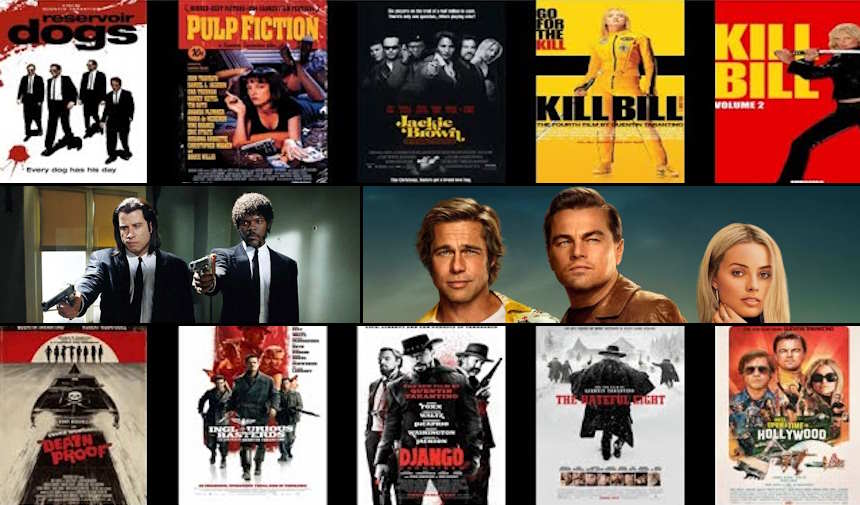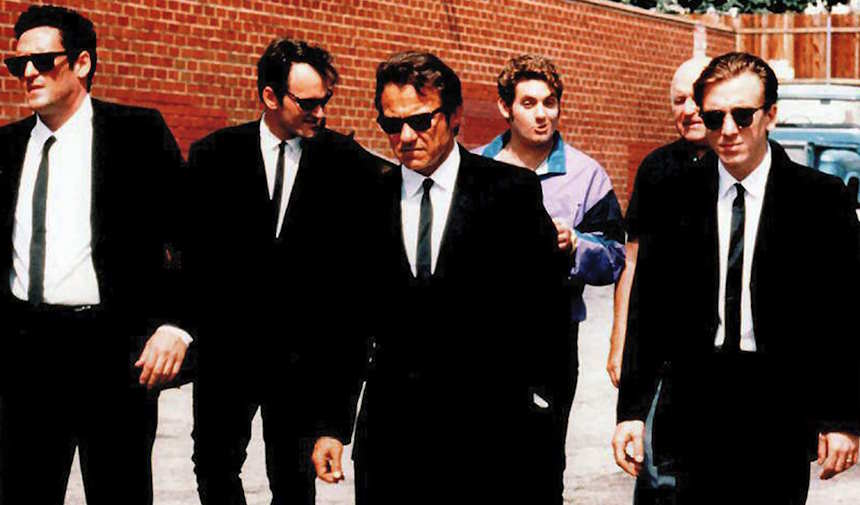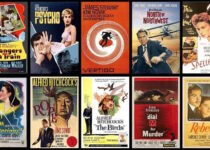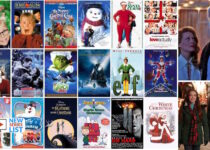Quentin Tarantino Movies in Chronological Order: Every Quentin Tarantino Movie in Order of Release
If you are seeking Quentin Tarantino movies in order of release, here is a perfect list of Quentin Tarantino movies in chronological order that you won’t want to miss. By following this list, you’ll experience the evolution of his distinctive style and storytelling techniques. Reservoir Dogs set the stage for Tarantino’s career with its non-linear storyline and razor-sharp dialogue. Pulp Fiction widely regarded as a masterpiece, this film intertwines multiple narratives with an unforgettable cast of characters.
Kill Bill, Death Proof, Inglourious Basterds, Django Unchained , The Hateful Eight and Once Upon a Time in Hollywood are the other Quentin Tarantino films. By watching these films in order, you’ll gain insight into how Quentin Tarantino has shaped contemporary cinema with his innovative approach to filmmaking and storytelling artistry. Don’t miss out on experiencing one of cinema’s most influential directors at work!
Quentin Tarantino Movies in Chronological Order: Every Quentin Tarantino Movie in Order of Release

Quentin Tarantino films are a testament to the brilliance of non-linear storytelling, showcasing his unparalleled genius in the world of cinema. Each movie he creates is a masterclass in narrative innovation, where scenes are intricately woven together, defying traditional chronological order. This unique approach not only captivates audiences but also challenges them to engage deeply with the plot.
Tarantino’s distinctive directorial style combines sharp dialogue, unforgettable characters, and unexpected twists, making every film an unforgettable experience. It’s this rare combination of elements that solidifies Tarantino’s status as a true cinematic master and visionary director.
The Chronological Order of Quentin Tarantino Movies Explained
Understanding the chronological order of Quentin Tarantino movies can provide a fresh perspective on his intricate storytelling and interconnected universe. Tarantino’s films are renowned for their non-linear narratives, but watching them in the correct sequence reveals an underlying timeline that enhances the viewing experience.
To start, “Reservoir Dogs” sets the stage with its gritty heist-gone-wrong plot. This film is followed by “Pulp Fiction,” which, while released later, fits next in the timeline due to overlapping characters and events. The story then shifts to “Jackie Brown,” a tale of crime and redemption that subtly connects with previous films through recurring motifs and characters.
Next in line is “Kill Bill: Volume 1” and “Volume 2,” which dive into the backstory of The Bride and her quest for vengeance, bridging connections with other Tarantino universes through shared references. Following this bloody saga is “Death Proof,” a grindhouse thriller that features some familiar faces from earlier films.
“Inglourious Basterds” rewrites history with its audacious World War II narrative, setting up a historical backdrop that influences later movies. Then comes “Django Unchained,” another historical piece set before modern times but rich in thematic links to Tarantino’s oeuvre.
Finally, we arrive at “The Hateful Eight” and “Once Upon a Time in Hollywood.” These films bring us closer to contemporary times while still weaving threads from earlier stories into their plots.
By following this chronological order of movies, you unlock new layers of understanding within Tarantino’s masterful storytelling. Watching his films in this sequence not only clarifies character arcs and plotlines but also deepens your appreciation for how meticulously crafted his cinematic universe truly is. So grab some popcorn and dive into the correct sequence of Quentin Tarantino films—it’s an experience no cinephile should miss!
Quentin Tarantino Movies in Order of Release

1. Reservoir Dogs (1992)
2. Pulp Fiction (1994)
3. Jackie Brown (1997)
4. Kill Bill: Volume 1 (2003)
5. Kill Bill: Volume 2 (2004)
6. Death Proof (2007)
7. Inglourious Basterds (2009)
8. Django Unchained (2012)
9. The Hateful Eight (2015)
10. Once Upon a Time in Hollywood (2019)
Pulp Fiction: Connecting the Dots in a Timeless Classic
When it comes to cinematic masterpieces, few films have left as indelible a mark as Quentin Tarantino’s “Pulp Fiction.” One of the most intriguing aspects of this timeless classic is its non-linear narrative. Understanding the Pulp Fiction chronology can be both a rewarding and enlightening experience for any movie buff.
The film’s structure defies traditional storytelling, but this is precisely what makes it so compelling. By piecing together the Pulp Fiction timeline, viewers can appreciate the intricate craftsmanship behind each scene. The story order isn’t merely shuffled for shock value; it’s a deliberate artistic choice that adds depth and complexity to each character’s journey.
For instance, starting with Pumpkin and Honey Bunny’s diner heist may seem like an odd choice until you realize how it bookends with Jules’ transformative moment later in the film. Similarly, Vincent Vega’s storyline gains new layers when you understand his fate in relation to Butch Coolidge’s narrative arc. Each viewing becomes an opportunity to connect these dots anew, revealing how every element interlocks within Tarantino’s masterful puzzle.
So why not dive back into this cinematic treasure? By exploring the Pulp Fiction story order and dissecting its unique chronology, you’ll uncover new dimensions that make this film an enduring piece of art.
Killing Bill: Unraveling the Saga from Start to Finish
For fans of Quentin Tarantino’s cinematic masterpiece, understanding the intricate narrative of “Kill Bill” is a thrilling journey in itself. Watching the saga unfold in chronological order offers a fresh perspective on The Bride’s relentless quest for vengeance.
The “Kill Bill” movie sequence is famously non-linear, jumping back and forth through time to reveal layers of The Bride’s story. However, piecing together the events in chronological order provides a deeper appreciation for her transformation from a betrayed assassin to an unstoppable force.
Starting with “Kill Bill: Volume 2,” we witness Beatrix Kiddo, known as The Bride, training under the brutal tutelage of Pai Mei. This early chapter sets the stage for her formidable skills and unyielding resolve. Following this, we delve into her tumultuous relationship with Bill and his Deadly Viper Assassination Squad.
As we move into “Kill Bill: Volume 1,” we see The Bride’s awakening from a coma and her methodical elimination of each squad member responsible for her suffering. Her journey is punctuated by iconic battles and poignant moments that highlight her unwavering determination to reclaim her life.
By watching “Kill Bill” in chronological order, viewers can fully grasp the epic scope of The Bride’s story timeline. It becomes clear how each event meticulously builds upon the last, culminating in a powerful narrative that resonates long after the final credits roll.
So next time you revisit Tarantino’s magnum opus, consider diving into it chronologically. You’ll find yourself even more captivated by The Bride’s saga from start to finish—an unforgettable tale woven with vengeance, redemption, and raw emotion.
The Hateful Eight and Django Unchained: Piecing Together the Western Narratives
When examining Quentin Tarantino’s filmography, it’s impossible to ignore the intricate tapestry he weaves between his Western masterpieces, “Django Unchained” and “The Hateful Eight.” These films, while distinct in their narratives and characters, share more than just a genre—they are interlinked through subtle references and thematic parallels that enrich the viewing experience.
“Django Unchained” introduces us to a pre-Civil War America where Django, a freed slave turned bounty hunter, embarks on a mission of vengeance and justice. The film is set in the 1850s-60s, establishing a timeline that offers rich historical context. On the other hand, “The Hateful Eight,” set post-Civil War in Wyoming during the 1870s, delves into themes of mistrust and survival against a backdrop of racial tension and frontier justice.
One can’t help but notice the chronological connection between these two films. The societal aftermath of Django’s era directly feeds into the world depicted in “The Hateful Eight.” Tarantino masterfully uses this timeline to explore how America’s violent past continues to echo through its characters’ lives. For instance, Major Marquis Warren (Samuel L. Jackson) from “The Hateful Eight” could be seen as an ideological successor to Django—both men shaped by their brutal experiences with racism and conflict.
Moreover, Western connections in Tarantino films go beyond mere timelines; they are embedded within his storytelling style. Both movies feature stark landscapes that serve as silent witnesses to human brutality and resilience. The desolate snowscapes of “The Hateful Eight” contrast sharply with the sun-soaked plains of “Django Unchained,” yet both settings underscore isolation and lawlessness—a hallmark of classic Western narratives.
Tarantino’s genius lies in his ability to create standalone stories that resonate on multiple levels when viewed together. By piecing together these Western narratives, audiences gain deeper insights into his commentary on American history and its enduring scars. Thus, exploring these connections not only enhances our appreciation for each film individually but also for Tarantino’s broader cinematic universe.
In conclusion, understanding the chronological connection between “Django Unchained” and “The Hateful Eight,” along with their shared thematic elements, reveals Quentin Tarantino’s nuanced approach to storytelling within the Western genre. It’s this meticulous crafting that solidifies his place as one of modern cinema’s most compelling auteurs.
The Grindhouse Experience: Death Proof’s Place in the Timeline
When diving into the Grindhouse experience, understanding the chronology of “Death Proof” is essential for any Tarantino aficionado. As part of the double-feature extravaganza alongside Robert Rodriguez’s “Planet Terror,” “Death Proof” holds a unique place in Quentin Tarantino’s cinematic universe.
To fully appreciate “Death Proof,” one must first comprehend its sequence within the Grindhouse movie order. Traditionally, audiences are encouraged to watch “Planet Terror” before delving into Stuntman Mike’s deadly escapades in “Death Proof.” This order not only preserves the intended flow but also enhances the overall atmospheric build-up that both directors meticulously crafted.
But where does “Death Proof” fit within Tarantino’s broader filmography? While each of his films exists in a shared universe filled with subtle connections and Easter eggs, “Death Proof” stands out as an homage to grindhouse cinema itself—a tribute nestled within his eclectic timeline. By situating it after iconic titles like “Pulp Fiction” and before more recent entries like “Once Upon a Time in Hollywood,” fans can see how it bridges his early work with his later stylistic evolution.
In essence, understanding Death Proof’s chronology explained is more than just placing it on a timeline; it’s about immersing oneself in Tarantino’s homage to an era of filmmaking that influenced him profoundly. So next time you embark on your Grindhouse journey, remember: watching these films in their intended order will provide you with an unparalleled cinematic experience that’s true to Tarantino’s vision.
Tarantino’s Universe: Shared Characters and Overlapping Storylines
Quentin Tarantino’s universe is a meticulously crafted web of shared characters, overlapping storylines, and subtle Easter eggs that keep fans endlessly intrigued. The Tarantino shared universe theory suggests that his films are not just standalone masterpieces but interconnected plots that exist within a larger narrative framework.
One of the most compelling aspects of this theory is the presence of overlapping characters. For instance, Vincent Vega from “Pulp Fiction” and Vic Vega from “Reservoir Dogs” are brothers, tying two seemingly separate stories together with familial bonds. This connection deepens our understanding of each character and enriches the viewing experience.
Moreover, Tarantino’s films are peppered with recurring themes and motifs that further solidify their interconnectedness. The infamous Red Apple cigarettes appear across multiple movies, serving as an Easter egg for eagle-eyed viewers. These small but significant details create a sense of continuity and cohesion across his filmography.
The interconnected plots in Tarantino’s universe also extend to subtle film connections that reward dedicated fans. For example, the character Earl McGraw appears in both “Kill Bill” and “Death Proof,” hinting at a shared world where these stories coexist. Such connections invite viewers to explore deeper meanings and relationships between different narratives.
In conclusion, the genius behind Tarantino’s storytelling lies not only in his individual films but in how they interweave to form a complex tapestry of interconnected plots and shared characters. This intricate universe keeps audiences coming back for more, eager to uncover every hidden link and thematic resonance within his cinematic world.
Conclusion: Experiencing Quentin Tarantino’s Masterpieces Like Never Before – Watch Them in Chronological Order!
If you’re a true cinephile or simply a fan of Quentin Tarantino’s unparalleled storytelling, there’s no better way to dive into his universe than by watching his films in chronological order. This unique approach not only provides a fresh perspective but also allows you to appreciate the intricate connections and hidden Easter eggs that Tarantino meticulously weaves throughout his cinematic tapestry.
By experiencing these masterpieces chronologically, you’ll uncover the nuanced evolution of characters and plotlines that span across different movies. From the early days of “Reservoir Dogs” and “Pulp Fiction” to the gritty revenge saga of “Kill Bill,” each film will unfold like chapters in an epic novel, revealing layers you might have missed on your first viewing.
Furthermore, this method enhances your understanding of Tarantino’s narrative genius. You’ll witness how he masterfully plays with time, creating suspense and drama that captivate audiences worldwide. The non-linear storytelling that he’s famous for becomes even more impressive when viewed through this lens.
So why settle for the traditional viewing order? Take your appreciation for Quentin Tarantino’s work to new heights by watching his films in chronological sequence. It’s an experience that promises to be as thrilling and unforgettable as the movies themselves.


